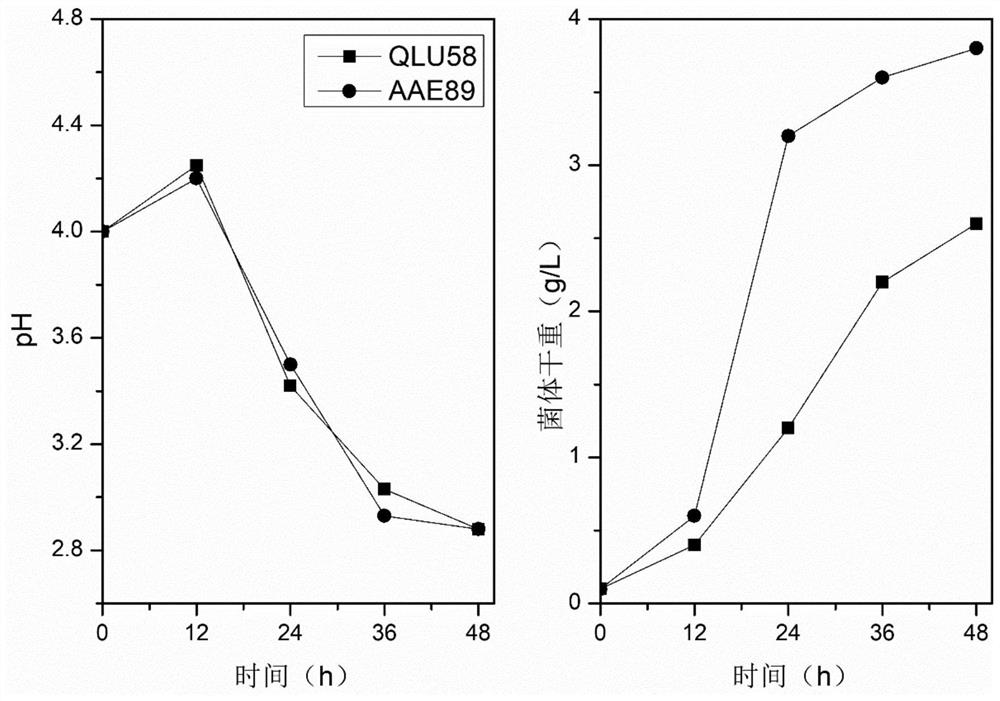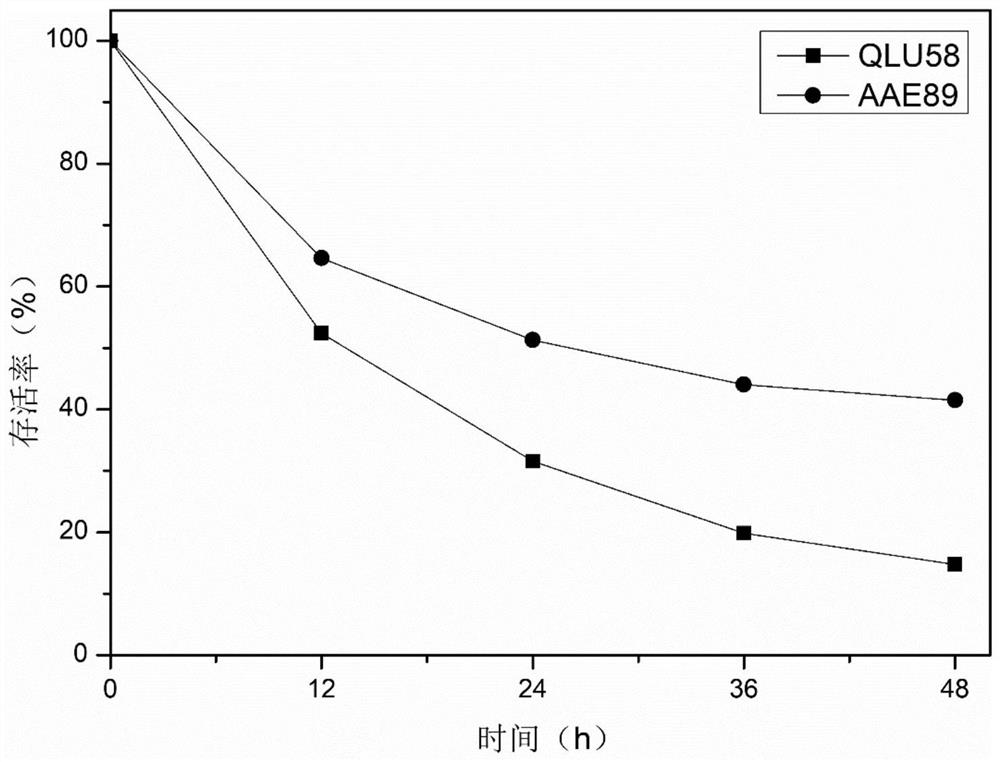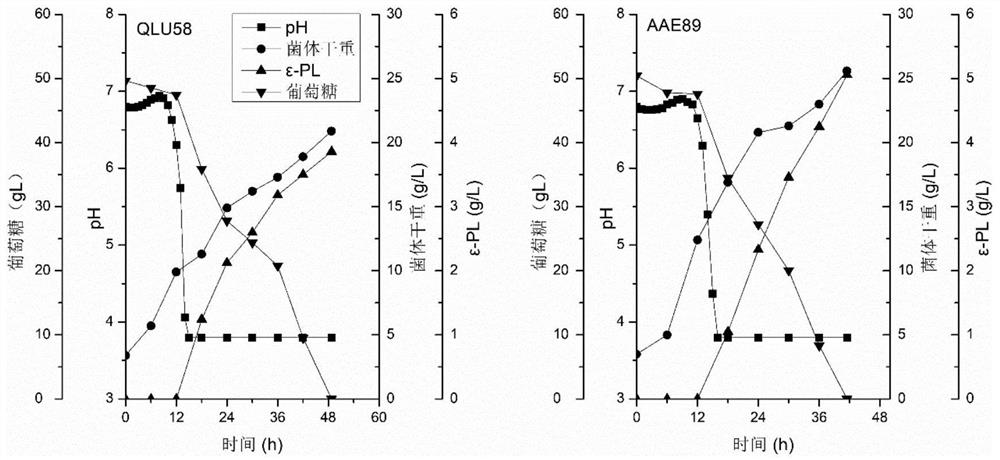Acid-resistant streptomyces albidus and application thereof in fermentation of epsilon-polylysine
A Streptomyces albicans, inoculation fermentation technology, applied in the direction of fermentation, bacteria, microorganism-based methods, etc., can solve problems such as stagnation of bacterial growth products
- Summary
- Abstract
- Description
- Claims
- Application Information
AI Technical Summary
Problems solved by technology
Method used
Image
Examples
Embodiment 1
[0043] Breeding method of Streptomyces parvus AAE89
[0044] Taking the wild Streptomyces parvus QLU58 screened in the campus soil of Qilu University of Technology Changqing Campus as the starting strain, it was cultured in the M3G liquid medium with pH 6.8 at 30°C and 200 rpm to the logarithmic growth phase, and the mass percentage was expressed as 10% of the inoculum was inoculated in the M3G liquid medium of pH 4.0, fermented and cultivated at 30°C 200rpm for 4 days (the pH dropped to about 3.1 after 1 day of fermentation, and then remained unchanged), and then the fermentation broth was calculated by mass percentage Re-transfer to fresh pH4.0 M3G liquid medium at a ratio of 10% for fermentation and culture for 4 days. After 10 transfers, reduce the initial pH of the M3G liquid medium to 3.9, and gradually reduce the pH of the M3G liquid culture through repeated operations. During this process, the ε-PL high-producing bacteria with improved acid resistance were regularly sc...
Embodiment 2
[0050] The growth characteristics of Streptomyces albus QLU58 and Streptomyces albus AAE89 under acid stress conditions, the specific experimental methods are as follows:
[0051] (1) The spores of the original bacteria Streptomyces albicans QLU58 and the selected acid-resistant bacteria Streptomyces albicans AAE89 were respectively inoculated into M3G liquid medium (the initial concentration of spores in the liquid medium after inoculation was 1×10 5 ~1×10 8 cells / mL), cultured at 30°C for 24 h on a 200 rpm shaker with ventilation and shaking as the seed solution.
[0052] (2) Inoculate the seed liquids of Streptomyces albicans QLU58 and Streptomyces albicans AAE89 into the M3G liquid medium of pH 4.0 with 4% inoculum amount in terms of mass percentage, and ferment at 30° C. with 200 rpm shaker ventilation and vibration On 2d, samples were taken every 12 hours in the middle, and the dry weight and pH of the bacteria were measured; as the fermentation process progressed, the ...
Embodiment 3
[0054] The acid tolerance experiment of Streptomyces albicans QLU58 and Streptomyces albicans AAE89, the specific experimental method is as follows:
[0055] (1) The spores of the original bacteria Streptomyces albicans QLU58 and the selected acid-resistant bacteria Streptomyces albicans AAE89 were respectively inoculated into M3G liquid medium (the initial concentration of spores in the liquid medium after inoculation was 1×10 5 ~1×10 8 cells / mL), cultured at 30°C for 24 h on a 200 rpm shaker with ventilation and shaking as the seed solution.
[0056] (2) Inoculate the seed liquids of Streptomyces albicans QLU58 and Streptomyces albicans AAE89 into the M3G liquid medium of pH 3.0 with 4% inoculum amount in terms of mass percentage, and cultivate them in a ventilated shaking table at 30°C and 200rpm After 48 hours, samples were taken every 12 hours in the middle, the diluted bacterial solution was spread on a plate, the number of viable bacteria was measured, and the survival...
PUM
 Login to View More
Login to View More Abstract
Description
Claims
Application Information
 Login to View More
Login to View More - R&D
- Intellectual Property
- Life Sciences
- Materials
- Tech Scout
- Unparalleled Data Quality
- Higher Quality Content
- 60% Fewer Hallucinations
Browse by: Latest US Patents, China's latest patents, Technical Efficacy Thesaurus, Application Domain, Technology Topic, Popular Technical Reports.
© 2025 PatSnap. All rights reserved.Legal|Privacy policy|Modern Slavery Act Transparency Statement|Sitemap|About US| Contact US: help@patsnap.com



